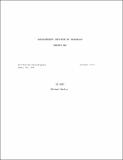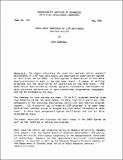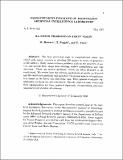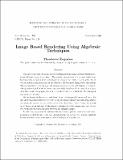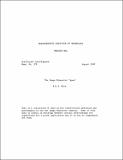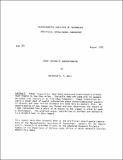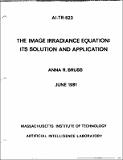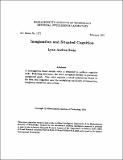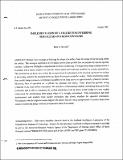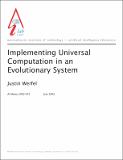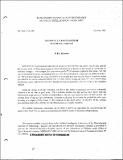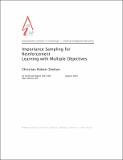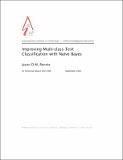Browsing Artificial Intelligence Lab Publications by Title
Now showing items 703-722 of 1835
-
I/O Test
(1967-10-01)IO TEST is intended as a hardware testing and debugging aid for use with the PDP-6 and its associated input multiplexer (analog to digital converter) and output multiplexer (digital to analog converter). While all characters ... -
Ideas About Management of LISP Data Bases
(1975-05-01)The paper advocates the need for systems which support maintenance of LISP-type data bases, and describes an experimental system of this kind, call DABA. In this system, a description of the data base's structure is ... -
Ideas About Management of LISP Data Bases
(MIT Artificial Intelligence Laboratory, 1975-01)The trend toward larger data bases in A.I. programs makes it desirable to provide program support for the activity of building and maintaining LISP data bases. Many techniques can be drawn from present and proposed systems ... -
IDEME: A DBMS of Methods
(MIT Artificial Intelligence Laboratory, 1985-08)In this paper, an intelligent database management system (DBMS) called IDEME is presented. IDEME is a program that takes as input a task specification and finds a set of methods potentially relevant to solving that task. ... -
Ill-Posed Problems and Regularization Analysis in Early Vision
(1984-04-01)One of the best definitions of early vision is that it is inverse optics --- a set of computational problems that both machines and biological organisms have to solve. While in classical optics the problem is to determine ... -
Ill-Posed Problems in Early Vision
(1987-05-01)The first processing stage in computational vision, also called early vision, consists in decoding 2D images in terms of properties of 3D surfaces. Early vision includes problems such as the recovery of motion and ... -
Image Based Rendering Using Algebraic Techniques
(1996-11-01)This paper presents an image-based rendering system using algebraic relations between different views of an object. The system uses pictures of an object taken from known positions. Given three such images it can ... -
Image Chunking: Defining Spatial Building Blocks for Scene Analysis
(1987-08-01)Rapid judgments about the properties and spatial relations of objects are the crux of visually guided interaction with the world. Vision begins, however, with essentially pointwise representations of the scene, such ... -
The Image Dissector "Eyes"
(1969-08-01)This is a collection of data on the construction operation and performance of the two image dissector cameras. Some of this data is useful in deciding whether certain shortcomings are significant for a given application ... -
Image Intensity Understanding
(1975-08-01)Image intensities have been processed traditionally without much regard to how they arise. Typically they are used only to segment an image into regions or to find edge-fragments. Image intensities do carry a great ... -
The Image Irradiance Equation: Its Solution and Application
(1981-06-01)How much information about the shape of an object can be inferred from its image? In particular, can the shape of an object be reconstructed by measuring the light it reflects from points on its surface? These questions ... -
Image-Based View Synthesis
(1997-01-01)We present a new method for rendering novel images of flexible 3D objects from a small number of example images in correspondence. The strength of the method is the ability to synthesize images whose viewing position ... -
Imagination and Situated Cognition
(1991-02-01)A subsumption-based mobile robot is extended to perform cognitive tasks. Following directions, the robot navigates directly to previously unexplored goals. This robot exploits a novel architecture based on the idea ... -
Implementation of a Theory for Inferring Surface Shape from Contours
(1982-08-01)Human vision is adept at inferring the shape of a surface from the image of curves lying across the surface. The strongest impression of 3-D shape derives from parallel (but not necessarily equally spaced) contours. ... -
Implementation of a Theory of Edge Detection
(1980-04-01)This report describes the implementation of a theory of edge detection, proposed by Marr and Hildreth (1979). According to this theory, the image is first processed independently through a set of different size filters, ... -
Implementing Distributed Systems Using Linear Naming
(1993-03-01)Linear graph reduction is a simple computational model in which the cost of naming things is explicitly represented. The key idea is the notion of "linearity". A name is linear if it is only used once, so with linear ... -
Implementing Universal Computation in an Evolutionary System
(2002-07-01)Evolutionary algorithms are a common tool in engineering and in the study of natural evolution. Here we take their use in a new direction by showing how they can be made to implement a universal computer. We consider ... -
The Implicit Constraints of the Primal Sketch
(1981-10-01)Computational theories of structure-from-motion and stereo vision only specify the computation of three-dimensional surface information at points in the image at which the irradiance changes. Yet, the visual perception ... -
Importance Sampling for Reinforcement Learning with Multiple Objectives
(2001-08-01)This thesis considers three complications that arise from applying reinforcement learning to a real-world application. In the process of using reinforcement learning to build an adaptive electronic market-maker, we find ... -
Improving Multi-class Text Classification with Naive Bayes
(2001-09-01)There are numerous text documents available in electronic form. More and more are becoming available every day. Such documents represent a massive amount of information that is easily accessible. Seeking value in this huge ...
